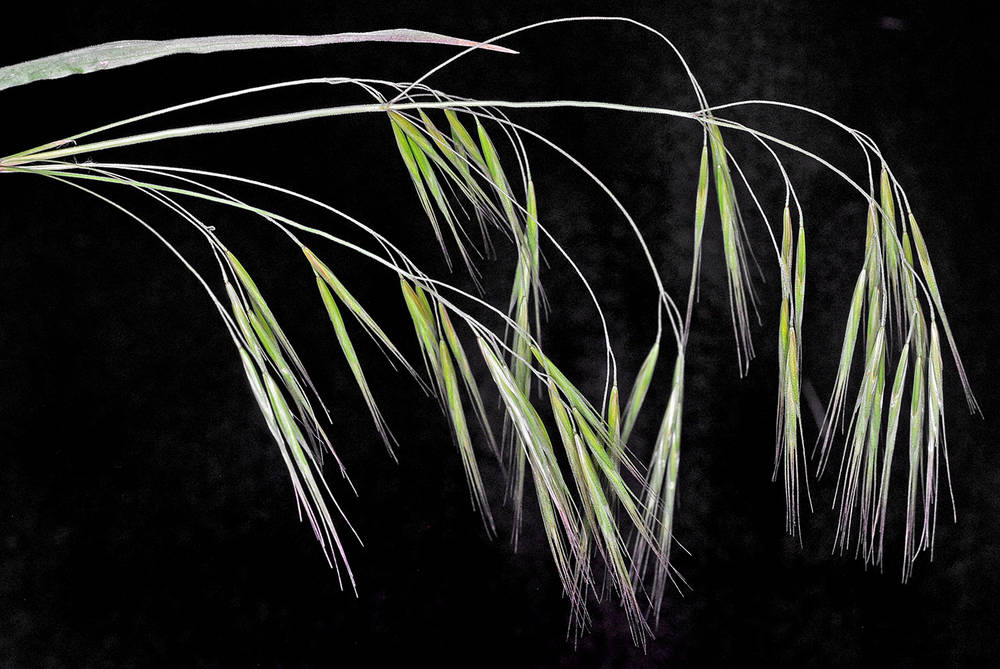Bromus tectorum
Bromus pacificus
cheatgrass, downy brome, downy chess
Pacific brome
puberulent.
internodes glabrous, sometimes pubescent near the nodes;
nodes (5)6–8, pubescent.
sheaths densely and softly retrorsely pubescent to pilose; upper sheaths sometimes glabrous;
blades 1–16 cm × 1–6 mm, softly hairy on both surfaces.
sheaths pilose;
ligules 2–4 mm;
blades 20–35(37) cm × 6–16 mm wide; flat;
lower surfaces glabrous;
upper surfaces pilose.
5–20 × 3–8 cm; open, nodding;
branches 1–4 cm, drooping, 1-sided and longer than the spikelets, usually at least 1 branch with 4–8 spikelets.
10–25 cm; open; more or less erect;
branches spreading to drooping.
10–20 mm, moderately laterally compressed, not densely crowded, 4–8 florets.
20–30 mm, elliptic to lanceolate; terete to moderately laterally compressed, with (4)6–10 florets.
villous, pubescent, or glabrous;
lower glumes 4–9 mm, 1-veined;
upper glumes 7–13 mm, 3–5-veined.
pubescent;
lower glumes 6–8.5 mm, 1(3)-veined;
upper glumes 8–11.5 mm, 3-veined.
9–12 mm, lanceolate, glabrous or pubescent to pilose, 5–7-veined;
tips acuminate; hyaline; bifid, with teeth 0.8–2(3)mm, awned;
lemma awns 10–18 mm; straight.
10–12 mm, lanceolate, rounded over the back; backs pubescent;
margins more densely pubescent;
tips acute; entire;
lemma awns 3.5–7 mm; straight.
0.5–1 mm.
2–4 mm.
=14.
Bromus tectorum
Bromus pacificus
Disturbed areas, sagebrush steppe, degraded grasslands, roadsides. 0–2400 m. BR, BW, Casc, Col, CR, ECas, Lava, Owy, Sisk, WV. CA, ID, NV, WA; throughout North America; worldwide. Exotic.
Bromus tectorum is a relatively short grass with drooping inflorescences. Similar B. sterilis and B. diandrus have longer glumes, lemmas, and awns, and spikelets that hang down at a shallower angle than those of B. tectorum. The introduction of B. tectorum to shrub steppe habitats during a time of massive overgrazing in the late 1800s has made restoration of native plant communities difficult or impossible, even where grazing no longer occurs. Fast-growing B. tectorum seedlings outcompete slower growing native grass seedlings for water in drying soils. At maturity, the awns make B. tectorum unpalatable to livestock.
Moist thickets and forest edges along the coast. 0–1700m. Est. North to AK. Native.
Bromus pacificus is a tall brome of coastal thickets, with widely spreading inflorescence branches and broad leaves. It most closely resembles B. sitchensis, which has glabrous or scabrous glumes. Bromus pacificus is often reported from inland sites west of the Cascades, but none of these reports have been confirmed and they are likely B. sitchensis.
Barbara Wilson, Richard Brainerd, Nick Otting
Barbara Wilson, Richard Brainerd, Nick Otting
- Local floras:
BC,
CA,
OR,
WA
- Local Web sites:
CalFlora,
CalPhotos,
Flora NW,
PNW Herbaria
WildflowerSearch
iNaturalist (observations)
USDA Plants Database
- LBJ Wildflower Center
- SEINet
- Plants of the World Online
- Encyclopedia of Life
- Wikipedia
- Google Image Search
- Local floras:
BC,
OR,
WA
- Local Web sites:
Flora NW,
PNW Herbaria
WildflowerSearch
iNaturalist (observations)
USDA Plants Database
- LBJ Wildflower Center
- SEINet
- Plants of the World Online
- Encyclopedia of Life
- Wikipedia
- Google Image Search




